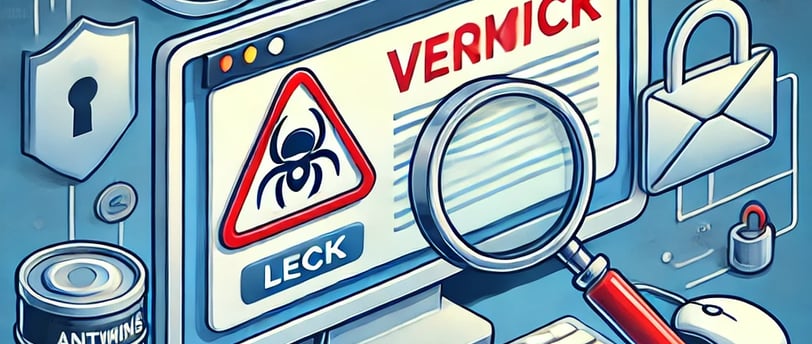Link and file verification
Tools and Tips to Ensure Your Online Security


Why is Verifying Links and Files So Important?
Hackers often disguise malicious links to appear legitimate and send infected attachments via email or messaging apps. These tactics can:
Steal personal and financial data.
Install malware on your device.
Redirect you to fake sites mimicking trusted pages.
Compromise the security of your network or organization.
Common Examples of Scams Using Links and Files
Phishing Links: Emails pretending to be from banks or reputable companies asking you to update personal details.
Infected Attachments: Documents that install viruses or ransomware when opened.
Redirect Scams: Shortened links leading to dangerous websites.
Verifying before clicking or downloading is your first line of defense.
How to Verify Suspicious Links
1. Hover Over the Link
One of the simplest ways to check a link is by hovering your mouse over it (without clicking). This reveals the actual address, allowing you to assess if it’s trustworthy.
Tips:
Ensure the domain is official. For example, www.yourbank.com is different from www.your-bank123.com.
Be wary of very long URLs or those with strange characters.
2. Use Link-Verification Tools
Several free online services analyze links for threats like malware or phishing.
Recommended Tools:
VirusTotal: Analyzes links using multiple antivirus services to detect malicious websites.
How to Use: Visit VirusTotal, paste the suspicious link, and click "Scan."
Google Safe Browsing: Google maintains a list of malicious websites and alerts users about threats.
How to Use: Go to Google Transparency Report and enter the link.
URLVoid: Provides detailed information about the domain’s reputation.
How to Use: Visit URLVoid, paste the link, and review the report.
CheckPhish.ai: Uses AI to identify phishing websites.
How to Use: Visit CheckPhish.ai, paste the link, and click "Analyze."
3. Expand Shortened Links
Shortened links, such as those generated by services like bit.ly or tinyurl, can hide malicious destinations.
How to Unmask Links:
Use services like CheckShortURL (checkshorturl.com).
Paste the shortened link to see its destination before clicking.
4. Look for Security Indicators on the Website
If you decide to visit the link, check for signs that the website is secure:
Look for HTTPS (indicated by a padlock in the address bar).
Avoid sites with grammar errors or amateurish designs.
Never input personal information on suspicious websites.
How to Verify Suspicious Files
1. Use an Updated Antivirus
Always keep a reliable antivirus program installed on your devices and configure it to automatically scan all downloaded files.
Recommended Antivirus Software:
Kaspersky
Avast
Norton
Bitdefender
Windows Defender (built into Windows)
2. Scan Files Before Opening
If you receive a file via email or download and are unsure about its safety, analyze it first.
File Analysis Tools:
VirusTotal: Allows file uploads for malware scanning.
How to Use: Visit VirusTotal, upload the suspicious file, and wait for the report.
Hybrid Analysis: Provides a detailed breakdown of files and links.
How to Use: Go to Hybrid Analysis, upload the file, and review the results.
MetaDefender: Scans files and links using multiple antivirus engines.
How to Use: Visit MetaDefender and upload the file.
3. Be Wary of Specific Formats
Files with extensions like .exe, .bat, .vbs, or .scr are more likely to contain malware. Avoid opening such files unless absolutely certain of their source.
4. Preview Files Without Downloading
Email services like Gmail allow you to preview files (e.g., PDFs or images) directly in your browser without downloading them. Use this feature to avoid unnecessary risks.
General Practices to Protect Against Suspicious Links and Files
1. Don’t Trust Unknown Senders
Avoid clicking links or downloading attachments from people you don’t know.
2. Confirm with the Sender
For suspicious messages that appear to come from someone you know, contact them directly (via phone or another channel) to verify authenticity.
3. Avoid Impulsive Clicking
Messages with a sense of urgency, such as “Update now!” or “You’ve won a prize!”, are often scams.
4. Keep Software Updated
Regularly update your operating system, browser, and apps to protect against vulnerabilities.
Tips for Businesses and Teams
If you manage or work in a team, consider these additional measures:
Employee Training
Educate your team on recognizing suspicious links and attachments.
Email Security Filters
Tools like Microsoft Defender for Office 365 or G Suite Security help block threats before they reach inboxes.
Clear Policies
Establish guidelines for downloading and sharing files in the workplace.
Conclusion
Verifying links and files is crucial for ensuring your online safety. Tools like VirusTotal, Google Safe Browsing, and Hybrid Analysis make this process simple and effective. Additionally, adopting good practices, such as recognizing security indicators and avoiding unknown senders, can prevent many problems.
Remember: Online safety starts with prevention. Take the time to verify before clicking or downloading, and you’ll be one step ahead of potential threats.
Security
Protect your family from online scams daily.
© 2024. All rights reserved.
